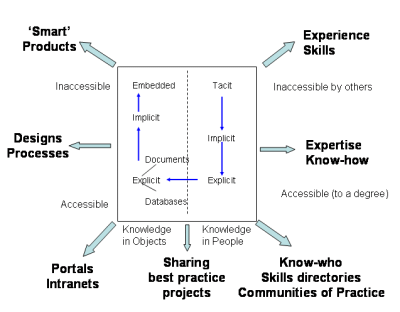 Managing knowledge means dealing with both tacit and explicit knowledge.
Managing knowledge means dealing with both tacit and explicit knowledge.
The diagram elaborates on the simple tacit-explicit split and shows examples of their manifestations.
The transfer of tacit knowledge throughout an enterprise involves complex processes, including the conversion from tacit to explicit, and vice versa.
Tacit and Explicit Knowledge
by David Skyrme Associates
http://www.skyrme.com/kmbasics/ktacit.htm
Tacit and Explicit Knowledge
The distinction between tacit and explicit knowledge is perhaps the most fundamental concept of knowledge management. Such a distinction was first made by Michael Polyani in the 1960s, but it forms one of the central planks of Nonaka and Takeuchi’s book The Knowledge-Creating Company. According to them, ‘explicit’ knowledge is formal and systematic:
Such knowledge is seen as “only the tip of the iceberg”. ‘Tacit’ knowledge, on the other hand, is described as:
The example I like to use to illustrate tacit knowledge is that of riding a bicycle (Polyani’s original example was that of an ice skater). The explicit knowledge for this might be a set of instructions along the lines of:
1. Stand besides your bike, hold both the handlebars and look forward.
2. Walk briskly forward or run a few paces taking the bike with you.
3. Now mount the bike, putting one foot on each pedal
4. Start pedalling while maintaining you balance
5. If you start to swerve or lose balance steer the bike into the direction in which you are falling.
etc. etc.
But would this convey the knowledge – the skill to ride a bicycle? The knowledge comes through that ‘ah-ha’ moment, and the ability to repeat it without thinking. You may have had someone to coach you and most likely hold the bike to help you balance. And you gain confidence with experience. Such knowledge (e.g. steps 4 and 5 above) is indeed difficult to put into words. It is embedded in your brain and you use it subconsciously.
The Tacit – Explicit Spectrum … and more besides
Although we have expressed here and in the knowledge hierarchy a clear distinction between tacit and explicit knowledge, this is really an oversimplification. Some explicit knowledge, such as factual knowledge can be made portrayed as very precise. Other types, such as the know-what and know-why may be less clear cut. There is also potential lack of clarity if not articulated in precise terms that leaves no room for ambiguity (we all know about politician’s summit agreement communiques, or statements made by both parties after an industrial dispute!).
At the other end of the spectrum there is deep tacit knowledge, such as belief and judgement, which is very personal and extremely difficult to transfer to other people. On the other hand quite a lot of tacit knowledge, with good ‘knowledge harvesting’ or elicitation, can be made explicit.
There is also implicit knowledge, which may be present in some combination of explicit and tacit knowledge but needs people to extract it. An example might be product knowledge that only becomes apparent through reverse engineering.
Knowledge Conversion and the Knowledge Spiral
by David Skyrme Associates
http://www.skyrme.com/kmbasics/kspiral.htm
One of the challenges is deciding how best to share tacit knowledge: what to share through tacit-to-tacit (person-to-person) processes, and what to convert to explicit knowledge, so that it more easily transferable. The work of Nonaka and Takeuchi[1] again gives a good conceptual background to consider these options, and others besides. They enunciated two key concepts – that of knowledge conversion processes and the knowledge spiral.
Knowledge Conversion Processes
Nonaka and Takeuchi defined four types of conversion processes which they describe as “fundamental to creating value”. The four are the combinations of conversion of explicit and tacit knowledge (see diagram).
Our research into KM success indicates that the conversion from one type to the other (i.e. tacit-to-explicit and vice versa) gives the most added value. Thus, knowledge once in explicit form can be more easily distributed, but then it does need converting and assimilating into another person’s tacit knowledge for application in a different context.
The Knowledge Spiral
In their book, Nonaka and Takeuchi say that “the key to knowledge creation lies in the mobilisation and conversion of tacit knowledge”. They go on to describe how organisational knowledge is created through processes in the knowledge spiral (see diagram).
Organizational knowledge starts at the individual level with thoughts or understanding (internalization). It them moves upwards through socialization, where individuals dialogue with their team colleagues. The ideas are then articulated (externalization) and become more widespread through diffusion of explicit knowledge (combination). As knowledge moves up the spiral knowledg is more widely spread and the spiral gets wider.
What also happens is that as individuals access organisational knowledge, they apply it and internalise new knowledge, thus setting the stage for an enhanced piece of knowledge to work its up the spiral.
The Concept in Practice
The terms socialization, externalization etc. are not in everyday use in knowledge management. The diagram below illustrates these processes (numbered as above) with decriptions that are more representative in practice.
Thus the tacit knowledge of an organisation in embodied in its people and the team and communities within which they operate, while the explicit knowledge is in various information repositories (databases, intranet pages etc.) A KM programme should therefore consider a range of strategies and practical techniques for each of the core conversion processes, which we have grouped under the broad headings shown – knowledge transfer mechanisms, knowledge harvesting, information management and the learning organization.